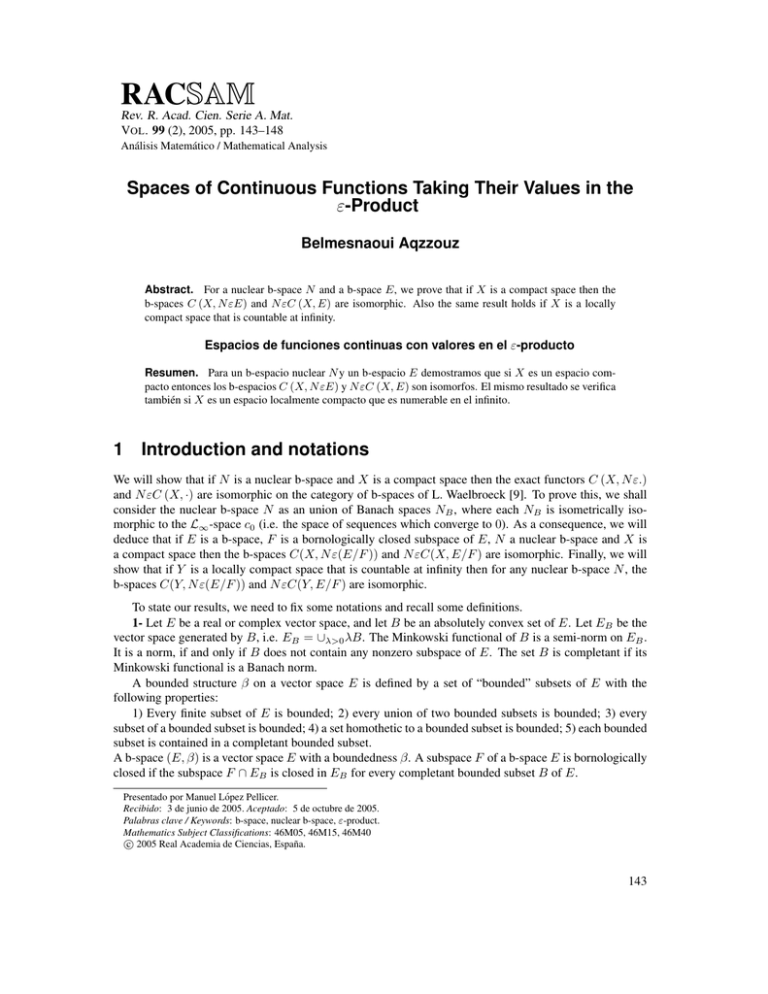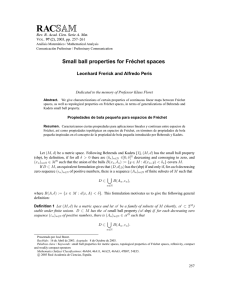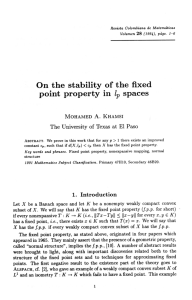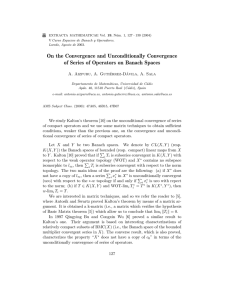Spaces of Continuous Functions Taking Their Values in the ε
Anuncio

RACSAM
Rev. R. Acad. Cien. Serie A. Mat.
VOL . 99 (2), 2005, pp. 143–148
Análisis Matemático / Mathematical Analysis
Spaces of Continuous Functions Taking Their Values in the
ε-Product
Belmesnaoui Aqzzouz
Abstract. For a nuclear b-space N and a b-space E, we prove that if X is a compact space then the
b-spaces C (X, N εE) and N εC (X, E) are isomorphic. Also the same result holds if X is a locally
compact space that is countable at infinity.
Espacios de funciones continuas con valores en el ε-producto
Resumen. Para un b-espacio nuclear N y un b-espacio E demostramos que si X es un espacio compacto entonces los b-espacios C (X, N εE) y N εC (X, E) son isomorfos. El mismo resultado se verifica
también si X es un espacio localmente compacto que es numerable en el infinito.
1
Introduction and notations
We will show that if N is a nuclear b-space and X is a compact space then the exact functors C (X, N ε.)
and N εC (X, ·) are isomorphic on the category of b-spaces of L. Waelbroeck [9]. To prove this, we shall
consider the nuclear b-space N as an union of Banach spaces NB , where each NB is isometrically isomorphic to the L∞ -space c0 (i.e. the space of sequences which converge to 0). As a consequence, we will
deduce that if E is a b-space, F is a bornologically closed subspace of E, N a nuclear b-space and X is
a compact space then the b-spaces C(X, N ε(E/F )) and N εC(X, E/F ) are isomorphic. Finally, we will
show that if Y is a locally compact space that is countable at infinity then for any nuclear b-space N , the
b-spaces C(Y, N ε(E/F )) and N εC(Y, E/F ) are isomorphic.
To state our results, we need to fix some notations and recall some definitions.
1- Let E be a real or complex vector space, and let B be an absolutely convex set of E. Let EB be the
vector space generated by B, i.e. EB = ∪λ>0 λB. The Minkowski functional of B is a semi-norm on EB .
It is a norm, if and only if B does not contain any nonzero subspace of E. The set B is completant if its
Minkowski functional is a Banach norm.
A bounded structure β on a vector space E is defined by a set of “bounded” subsets of E with the
following properties:
1) Every finite subset of E is bounded; 2) every union of two bounded subsets is bounded; 3) every
subset of a bounded subset is bounded; 4) a set homothetic to a bounded subset is bounded; 5) each bounded
subset is contained in a completant bounded subset.
A b-space (E, β) is a vector space E with a boundedness β. A subspace F of a b-space E is bornologically
closed if the subspace F ∩ EB is closed in EB for every completant bounded subset B of E.
Presentado por Manuel López Pellicer.
Recibido: 3 de junio de 2005. Aceptado: 5 de octubre de 2005.
Palabras clave / Keywords: b-space, nuclear b-space, ε-product.
Mathematics Subject Classifications: 46M05, 46M15, 46M40
c 2005 Real Academia de Ciencias, España.
143
B. Aqzzouz
Given two b-spaces (E, βE ) and (F, βF ), a linear mapping u : E −→ F is bounded, if it maps bounded
subsets of E into bounded subsets of F . The mapping u : E −→ F is bornologically surjective if for every
B 0 ∈ βF , there exists B ∈ βE such that u(B) = B 0 .
We denote by b the category of b-spaces and bounded linear mappings. For more information about bspaces we refer the reader to [3] and [9].
2- The ε-product of two Banach spaces E and F is the Banach space EεF of linear mappings E 0 −→ F
whose restrictions to the closed unit ball BE 0 of E 0 are continuous for the topology σ(E 0 , E). If Ei and Fi
are Banach spaces and ui : Ei −→ Fi are bounded linear mappings, i = 1, 2, the ε-product of u1 and u2 is
the bounded linear mapping u1 εu2 : E1 εE2 −→ F1 εF2 , f 7−→ u2 ◦ f ◦ u01 , where u01 is the dual mapping
of u1 . It is clear that u1 εu2 is injective when u1 and u2 are injective. If G is a Banach space and F is a
closed subspace of a Banach space E, then GεF is a closed subspace of GεE. See [5] and [8] for more
information about the ε-product.
2
Main results
The ε-product of a b-space G and a Banach space E is the space GεE = ∪B GB εE, where B ranges over
the bounded completant subsets of the b-space G. On GεE we define the following bornology of b-space:
a subset C of GεE is bounded if there exists a completant bounded disk A of G such that C is bounded in
the Banach space GA εE. It is clear that if F is a bornologically closed subspace in G, the subspace F εE
is a bornologically closed subspace in GεE.
Now, if G and E are two b-spaces, the ε-product of G and E is the space GεE = ∪A,B GA εEB , where
A (resp. B) ranges over the bounded completant subsets of the b-space G (resp. E). We endow GεE with
the following bornology of b-space: a subset C of GεE is bounded if there exists a completant bounded
disk A of G (resp. B of E) such that C is bounded in the Banach space GA εEB .
Let E be a Banach space, F a closed subspace of E and (ϕi )i∈I a set of continuous linear functionals on E such that F = {y ∈ E : for all i ∈ I, ϕi (y) = 0}. If G is a Banach space, then GεF =
{f ∈ GεE : for all i ∈ I, IdG εϕi (f ) = 0} (indeed, f ∈ GεF iff for all i ∈ I and for all x ∈ G0 ,
ϕi (f (x)) = (ϕi ◦ f )(x) = 0 and ϕi ◦ f = (IdG εϕi )(f )).
As application, we have c0 εE ' c0 (E), in fact, the Banach space C(N∞ ) is isomorphic to the space of
convergent sequences c, where N∞ is the Alexandroff compactification of N. As c0 εE is isomorphic to a
closed subspace of cεE, containing the sequences of elements of E which converge to 0, and cεE ' c(E),
the subspace c0 (E) is isomorphic to the subspace of c (E) containing the sequences of elements of E which
converge to 0.
In [6], W. Kaballo introduced the class of locally convex spaces which are ε-spaces. For us, a b-space
G is an εb-space if the bounded linear mapping IdG εu : GεE −→ GεF , f 7−→ u ◦ f is bornologically
surjective when u : E −→ F is a surjective bounded linear mapping between Banach spaces.
Recall that a Banach space E is an L∞,λ -space, λ ≥ 1, if and only if every finite-dimensional subspace F of E is contained in a finite-dimensional subspace F1 of E such that d(F1 , ln∞ ) ≤ λ,
where
n = dim F1 , ln∞ is Kn (K = R or C) with the norm sup1≤i≤n |xi |, and d (X, Y ) = inf{T T −1 :
T : X −→ Y isomorphism} is the Banach-Mazur distance of the Banach spaces X and Y . A Banach space
E is an L∞ -space if it is an L∞,λ -space for some λ ≥ 1. For more information about L∞ -spaces we refer
the reader to [7].
It is clear that any L∞ -space is an εb-space, the ε-product of two εb-spaces is an εb-space and a
bornologically complemented subspace of an εb-space is εb-space.
Also, it is easy to show that a b-space G is an εb-space if and only if, for every bounded linear mapping
u : X −→ Y that is bornologically surjective, the bounded linear mapping IdG εu : GεX −→ GεY ,
f 7−→ u ◦ f is bornologically surjective, where X and Y are b-spaces. If G is an εb-space, the functor
Gε. : b −→ b is exact, and it follows that if E is a b-space and F is a bornologically closed subspace of E,
we have Gε(E/F ) = (GεE) / (GεF ).
144
Spaces of continuous functions taking their values in the ε-product
For examples of εb-spaces, if G is a nuclear b-space (i.e. every bounded completant subset B of G is
included in a bounded completant subset A of G such that the inclusion iAB : GB −→ GA is a nuclear
mapping), by [3], there exists a net (I, ≤) and a base (B0,i )i∈I of the bornology of G such that GB0,i is
isometrically isomorphic to the Banach space c0 and G = ∪i∈I GB0,i . Since c0 is an L∞ -space [7] and the
inductive limit is an exact functor on the category b [4], it follows that every nuclear b-space is an εb-space.
Recall from [1] that if X is a compact topological space and E is a b-space, we defined C (X, E) as the
b-space ∪B C (X, EB ), where B ranges over the bounded completant subsets of E and C(X, EB ) is the
space of continuous mappings from X into the Banach space EB .
Since the Banach space C (X) is an L∞ -space [7], the functor C (X, ·) : Ban −→ Ban is exact [6]
and since the inductive limit is an exact functor on the category b [4], it follows that the functor C (X, ·) :
b −→ b is also exact as we showed this in [1]. This implies that, if X is a compact, E is a b-space and F
a bornologically closed subspace of E, then C(X, E/F ) = C(X, E)/C(X, F ).
Now, we are in position to prove our first result.
Theorem 1 Let X be a compact space, N a nuclear b-space and E a Banach space. Then the b-spaces
C (X, N εE) and N εC (X, E) are isomorphic.
P ROOF. As the functor C (X, ·) : b −→ b is exact [1], the b-space C (X, N εE) is defined as the
union of the Banach spaces C (X, Ni εE), where N = ∪i∈I Ni .
On the other hand, by the definition of the ε-product of a b-space by a Banach space, we have that
N εC (X, E) = ∪i (Ni εC (X, E)).
First we shall prove that the spaces C (X, Ni εE) and Ni εC (X, E) are isomorphic. As each Banach space Ni is isometrically isomorphic to c0 [3], we shall construct an isomorphism C (X, c0 εE) −→
c0 εC (X, E). Since c0 εE ' c0 (E) for all Banach spaces E, so we have to construct an isomorphism
C (X, c0 (E)) −→ c0 (C (X, E)).
Let f ∈ C (X, c0 (E)). For each x ∈ X, f (x) is a sequence (fn (x))n of elements of E. We have got
a sequence (fn )n of continuous functions X −→ E. Let us prove that this sequence is in Banach space
c0 (C (X, E)), i.e. it converges uniformly to 0 on X.
For all ε > 0, and for all x ∈ X, let Vx be an open neighbourhood of x such that for all x0 ∈ Vx ,
we have kf (x) − f (x0 )kc0 (E) ≤ ε. We cover X by a finite set of open subsets {Vx1 , . . . , Vxn }. For all
i ∈ {1, . . . , n}, (f (xi ))i is a sequence of elements of E tending to 0. Thus there exists m ∈ N such that
for all i ∈ I and for all n > m, we have kfn (x)k ≤ ε. Clearly this implies that for all x ∈ X, and all
n > m, kfn (x)k ≤ 2ε.
We have a map C (X, c0 (E)) −→ c0 (C(X, E)) and it is immediate that this mapping preserves the
norm. Let us show that it is surjective. Let (fn )n be a sequence of continuous functions X −→ E
which converges uniformly to 0 on X. We define a function X −→ c0 (E) by f (x) = (fn (x))n . It
remains to prove its continuity. First, we can find an integer m such that for all n > m, and for all x,
kfn (x)k ≤ ε/2. Then for x0 ∈ X, we choose neighbourhoods V1 , . . . , Vm−1 of x0 such that for all
x ∈ Vk , kfk (x) − fk (x0 )k ≤ ε with k = 1, . . . , m − 1. In the intersection of these neighbourhoods, we
get kf (x) − f (x0 )kc0 (E) ≤ ε.
Thus for all i ∈ I, the Banach spaces C (X, Ni εE) and Ni εC (X, E) are isomorphic. If we apply the
functor inductive limit which is an exact functor on the category of b-spaces [4], we obtain the result. As consequences, we obtain the following results:
Corollary 1 Let X be a compact space, N a nuclear b-space and E a b-space. Then the b-spaces
C (X, N εE) and N εC (X, E) are isomorphic.
P ROOF. In fact, by definition, we have C (X, N εE) = lim
−→B C (X, N εEB ). Since C (X, N εEB ) =
N εC (X, EB ), we deduce that
C (X, N εE) = lim
−→B (N εC (X, EB )) = N ε(lim
−→B C (X, EB )) = N εC (X, E) . 145
B. Aqzzouz
Corollary 2 Let X be a compact space, N a nuclear b-space, E a b-space and F a bornologically closed
subspace of E. Then the b-spaces C(X, N ε(E/F )) and N εC(X, E/F ) are isomorphic.
P ROOF. Since N is an εb-space, we have N ε(E/F ) = (N εE) / (N εF ). On the other hand, the
Banach space C(X) is an L∞ -space and it follows from [1], that
C(X, N ε(E/F )) = C(X, (N εE) / (N εF )) = C(X, N εE)/C(X, N εF )
= (N εC (X, E)) / (N εC (X, F )) = N ε(C(X, E)/C(X, F )) = N εC(X, E/F ). Recall from [3] that the bornological projective tensor product E ⊗πb F (resp. the bornological injective
ˆ
tensor product E ⊗εb F ) of two b-spaces E and F is defined as the b-space lim
−→B,C (EB ⊗π FC ) (resp.
ˆ
lim
−→B,C (EB ⊗ε FC )), where B (resp. C) ranges over the bounded completant subsets of E (resp. F ), the
ˆ π FC (resp. EB ⊗
ˆ ε FC ) is the completion of the space
inductive limit is taken in the category b and EB ⊗
EB ⊗
norm (resp. the injective tensor
kzkπ =
PFnC with the projectivePtensor
Pnnorm)0 given 0by the formula
n
0
0
0, y ∈
inf { k=1 kxk k ky
k
:
u
=
x
⊗
y
}
(resp.
kzk
=
sup{|
x
(x
)
y
(y
)|
:
x
∈
B
k
k
k
k
k
E
k=1
ε
k=1
Pn
0
0
0
0
0
BF }) where z = k=1 xk ⊗ yk and BE , BF are the closed unit balls of E , F respectively.
ˆ ε FC induces the same norm on EB ⊗ FC than the
Note that the complete injective tensor product EB ⊗
ˆ
ε-product EB εFC , moreover EB ⊗ε FC is a closed subspace of EB εFC . These two spaces are sometime
ˆ ε FC is isometrically isomorphic to EB εFC if EB or FC has the
identical, in fact, the Banach space EB ⊗
approximation property.
Corollary 3 Let X be a compact space, N a nuclear b-space, E a b-space and F a bornologically closed
subspace of E. Then the b-spaces C(X, N ⊗πb (E/F )) and N ⊗πb C(X, E/F ) are isomorphic.
P ROOF. Since N is a nuclear b-space, the functor N ε. is exact, and hence the b-spaces N ε(E/F )
and (N εE)/(N εF ) are naturally isomorphic. In other hand, it follows from [3, Theorem 2, p. 78], that
N ⊗πb (E/F ) and N ⊗εb (E/F ) are naturally isomorphic. Next, the b-spaces N ε(E/F ) and N ⊗εb (E/F )
are isomorphic because N has the approximation property. Finally, the result follows from Corollary 1 and
Corollary 2. Let (X, d) be a metric compact space and E be a Banach space. In [1], we defined the b-space C(X, E)e
as the space C(X, E) that we endow with the equicontinuous boundedness, i.e. a subset A of C(X, E) is
bounded if A is uniformly bounded and equicontinuous. We also showed that C (X)e εE = C (X, E)e .
The same result rest true when E is a b-space. In fact:
Proposition 1 Let (X, d) be a metric compact space and let E be a b-space. Then the b-spaces C (X)e εE
and C (X, E)e are isomorphic.
P ROOF. By the definition of the ε-product of two b-spaces, we have C (X)e εE = ∪B (C (X)e εEB ).
Since C (X, EB )e = C (X)e εEB and the functor C (X, ·)e : b −→ b is exact [1], we obtain that
∪B C (X, EB )e = C (X, ∪B EB )e . If follows that C (X)e εE = C (X, E)e . Proposition 2 Let (X, d) be a metric compact space, N a nuclear b-space, E a b-space and F a
bornologically closed subspace of E, then the b-spaces C(X, N ε(E/F ))e and N εC(X, E/F )e are isomorphic.
P ROOF. The functor C (X, ·)e : b −→ b is exact [1], then C(X, E/F )e = C(X, E)e /C(X, F )e . It
follows that
C(X, N ε(E/F ))e = C(X, N εE)e /C(X, N εF )e = C (X)e ε(N εE)/C (X)e ε(N εF )
= N ε(C (X)e εE)/N ε(C (X)e εF ) = N ε(C(X, E)e /C(X, F )e )
= N εC(X, E/F )e . 146
Spaces of continuous functions taking their values in the ε-product
Finally, we will prove an analogue result of Theorem 1 for locally compact topological spaces X which
are countable at infinity.
Q∞
Let (En )n be a family
Q∞ of b-spaces. We endow the direct product n=0 En , with the product boundedness
i.e. a subset Q
B of n=0 En is bounded if pn (B) = {pn (x) : x ∈ B} is bounded in En for all n ∈ N,
∞
whereQpm : n=0 En −→ Em is the canonical projection. It is clear
Q∞that all the canonical projections
∞
pm : n=0 En −→ Em are bounded whenever we endow the space n=0 En with the product boundedness.
To prove the next Theorem (Theorem 2), we need to recall the following result which comes from [2,
Proposition 3.11].
Proposition
3 LetQ
N be a nuclear b-space, and for all n ∈ N, let En be a b-space. Then the b-spaces
Q∞
∞
N ε( n=0 En ) and n=0 (N εEn ) are isomorphic.
Theorem 2 Let N be a nuclear b-space, E a b-space and U a locally compact space which is countable
at infinity. Then the b-spaces C (U, N εE) and N εC (U, E) are isomorphic.
P ROOF. The space U is an union of a sequence of open sets Un , each relatively compact in the interior
of the following one. We consider the “disjoint union” V of the relatively compact sets Un . For any b-space
E, there exists a bounded linear mapping Ψ : C (U, E) −→ C (V, E), which maps a function f ∈ C (U, E)
onto its composition with the obvious mapping V −→ U .
We find next a bounded linear mapping Ψ0 : C (V, E) −→ C (U, E). The locally compact space U is
paracompact. We have a partition of the unity, (ϕn )n such that,P
sup p(ϕn ) ⊂ U̇n for all n where U̇n is the
interior of Un . Then Ψ0 is defined by the formula Ψ0 ((fn )n ) = n∈N ϕn fn .
The mapping Ψ0 is a left inverse of Ψ so it is bornologically surjective. Since the nuclear b-space N is
an εb-space, it follows that the bounded linear mapping IdN εΨ0 : N εC (V, E) −→ N εC (U, E) is bornologically surjective. There exists also a bornologically surjectiveQ
mapping C (V, N εE)Q−→ C (U, N εE).
∞
∞
By the Proposition
3
and
Corollary
2,
N
εC
(U,
E)
'
N
ε(
n=0 C (Un , E)) '
n=0 N εC (Un , E)
Q∞
Q∞
and C (U, N εE) ' n=0 C (Un , N εE) ' n=0 N εC (Un , E), we see that C (U, N εE) ' N εC (U, E).
Moreover, by this isomorphism, the kernel of the mapping N εC (V, E) −→ N εC (U, E) correspond to the
kernel of the mapping C (V, N εE) −→ C (U, N εE). Corollary 4 Let U be a locally compact space that is countable at infinity, N a nuclear b-space, E a bspace and F a bornologically closed space of E. Then the b-spaces C(U, N ε(E/F )) and N εC(U, E/F )
are isomorphic.
References
[1] Aqzzouz, B. (2001). Généralisations du Théorème de Bartle-Graves, C. R. Acad. Sci. de Paris 333, 10, 925–930.
[2] Aqzzouz, B. (2003). On some isomorphism on the category of b-spaces, Sib. Mat. Zh. 44, 5, 961–971
[3] Hogbe Nlend, H. (1971). Théorie des bornologies et applications, Lecture Notes in Math. 213.
[4] Houzel, C. (1972). Séminaire Banach, Lecture Notes in Math., 227,
[5] Jarchow, H. (1981). Locally convex spaces, B.G. Teubner Stuttgart.
[6] Kaballo, W. (1977). Lifting theorems for vector valued functions and the ε-product, Proc. of the first Poderborn
Conference on Functional Analysis, 27, 149–166.
[7] Lindenstrauss, J. and Tzafriri, L. (1973). Classical Banach spaces, Lecture Notes in Math. 338.
[8] Waelbroeck, L. (1966). Duality and the injective tensor product. Math. Ann., 163, 122–126.
147
B. Aqzzouz
[9] Waelbroeck, L. (1971). Topological vector spaces and algebras, Lecture Notes in Math. 230.
Belmesnaoui Aqzzouz
Université Ibn Tofail
Faculté des Sciences
Département de Mathématiques
Equipe d’Analyse Fonctionnelle
B. P. 133, Kénitra
Morocco
[email protected]
148



